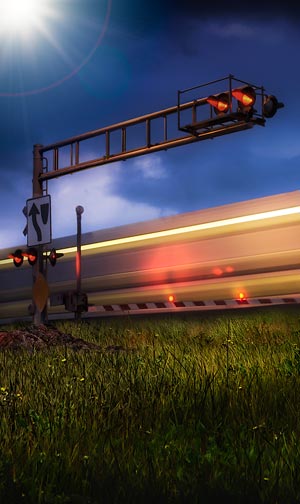TV Station Underscores Man’s Battle With BNSF Over Crossing Where Mother Died
(Bois D’Arc, Missouri – January 18, 2012)
The trees are gone now, having been cleared by the railroad after the fatal accident that took the life of Brian Weatherford’s 68-year-old mother, Helen, at the dangerous, unguarded crossing of Burlington Northern Santa Fe railroad tracks and Greene County, MO FM-47 near Bois D’Arc, MO the morning of this past November 17, but the pain of the loss of “his best friend, his buddy and his mother all in the same day” remains.
Photos taken the day of the tragedy show the trees and trackside brush virtually concealed the oncoming train from the motorist’s view as cars approach from the same positions Helen Weatherford’s vehicle and the BNSF coal train occupied that day. On Wednesday’s newscast, KSPR-TV Reporter Joanna Small demonstrated the effect the existence of the trees that fateful day would have had on any motorist approaching the deadly crossing: only their removal – which has since been accomplished – or lights, bells and gates (the crossing is equipped solely with passive railroad crossbuck signage) – would have saved Helen’s life.
“Where the first tree was located and the second tree, with the sun in your eyes, put yourself in that position; it was just a perfect recipe for disaster,” Brian told the KSPR-TV reporter. “If the trees weren’t there I know it wouldn’t have happened. If there were signals there it wouldn’t have happened,” Brian continued.
The woman Brian Weatherford called “the most conservative driver I ever met,” had “Her brain stem…severed from her spine,” from the impact with the train.
Because law enforcement officials were at the crossing attempting to educate drivers on safety procedures when crossing railroad tracks on Wednesday, Reporter Small also interviewed Missouri Operation Lifesaver (a basically railroad-funded non-profit, public service organization) chief Rick Mooney, a former State of Missouri employee who now is paid by Operation Lifesaver and its railroad sponsors to administer the program statewide.
“”They’re almost 50-50, but really it’s a little bit higher than 55% occur at crossings equipped with flashing lights, signals or gates, what we call active crossings that give an indication a train is approaching,” Mooney said of the number of accidents occurring at signalized as opposed to passive railroad crossings in Missouri.
But for the Weatherford family, 100% have occurred at non-signalized crossings, and all have been fatal.
The truth is that lights and gates at crossings could prevent 90% accidents at railroad crossings.


